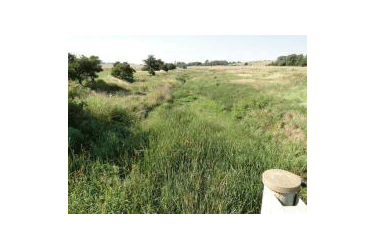UI study determines areas vulnerable to riparian erosion

- Riparian erosion is one of the major causes of sediment and contaminant load to streams.
- Soil type and land use are two of the most important variables in riparian erosion.
- Identifying the most vulnerable areas for riparian erosion allows conservation and management practices to focus on areas needing the most attention and resources.
Urbana, Ill. - Researchers at the University of Illinois collaborated with colleagues in Oklahoma to identify areas along a riparian zone, that is, alongside rivers that are susceptible to erosion.
Maria Chu, an assistant professor in agricultural and biological engineering (ABE), and Alejandra Botero-Acosta, a Ph.D. student in ABE, developed a modeling framework which they used to identify those areas in the Fort Cobb Reservoir Experimental Watershed (FCREW) in southcentral Oklahoma. The FCREW has three sub-watersheds: Cobb, Lake, and Willow. Chu, Botero-Acosta, and their colleagues used readily available USDA environmental data from the area.
“A healthy riparian buffer intercepts suspended solids, nitrogen, and phosphorous,” says Botero-Acosta, “reducing sediment load and nutrient pollution in the rivers. We found in our literature review that 50 percent of the sediments in the river were coming from the riparian zone. We wanted to identify those locations so conservation and management practices can be focused on those points.”
Predicting riparian erosion at the watershed scale is challenging because of the complex interactions between the different variables that govern soil erosion and the inherent uncertainties in measuring those processes. In this study, Botero-Acosta says they found that soil type and land use were the two most important variables.
“The most vulnerable areas for erosion were found to be located at the upper riparian zone of the Cobb and Lake sub-watersheds. The soil there is sand and silt, which is very prone to erosion,” she says. “Land use was also important. Livestock grazing and row crops thinned the vegetation, so that increased erosion.”
Hydrological variables that are dynamic, such as rainfall, lateral and overland inflow, and discharge, were not as significant in predicting the location of erosion. However, Botero-Acosta says “In order to convert flow into velocity, we needed a cross section of the river, and we didn’t have that data. For future work, implementing that kind of data will give us better results regarding hydrological variables, because we do think that discharge can affect riparian erosion.”
Botero-Acosta says mitigating riparian erosion is ultimately beneficial to the population at large. “A watershed provides ecosystems services to the community, which people sometimes take for granted. Fresh water to drink, water to irrigate crops, oxygen-rich water to support fish populations, those are all connected to a healthy watershed.”
Chu will be conducting a similar study in the Upper Sangamon Watershed, near Decatur. The Sangamon watershed is almost twice the size of the Fort Cobb watershed, and the area is approximately 90 percent agricultural, as opposed to 60 percent agricultural in Oklahoma. Chu received funding from the USDA’s National Institute of Food and Agriculture to do a hydrologic assessment of the watershed. The study will use a suite of hydrologic and environmental models to simulate different land management practices and their effects on ecosystems services such as water clarity, nutrient reduction, and fish species richness.
The Fort Cobb study, “Riparian erosion vulnerability model based on environmental features,” is written by Chu and Botero-Acosta, along with colleagues Jorge Guzman, research hydrologist at the Center for Spatial Analysis, University of Oklahoma; Daniel Moriasi, research hydrologist at USDA-ARS Grazinglands Research Laboratory, El Reno, Oklahoma; and Patrick Starks, soil scientist at USDA-ARS Grazinglands Research Laboratory, El Reno, Oklahoma. It appears in the Journal of Environmental Management, and a pdf of the full paper is available online.